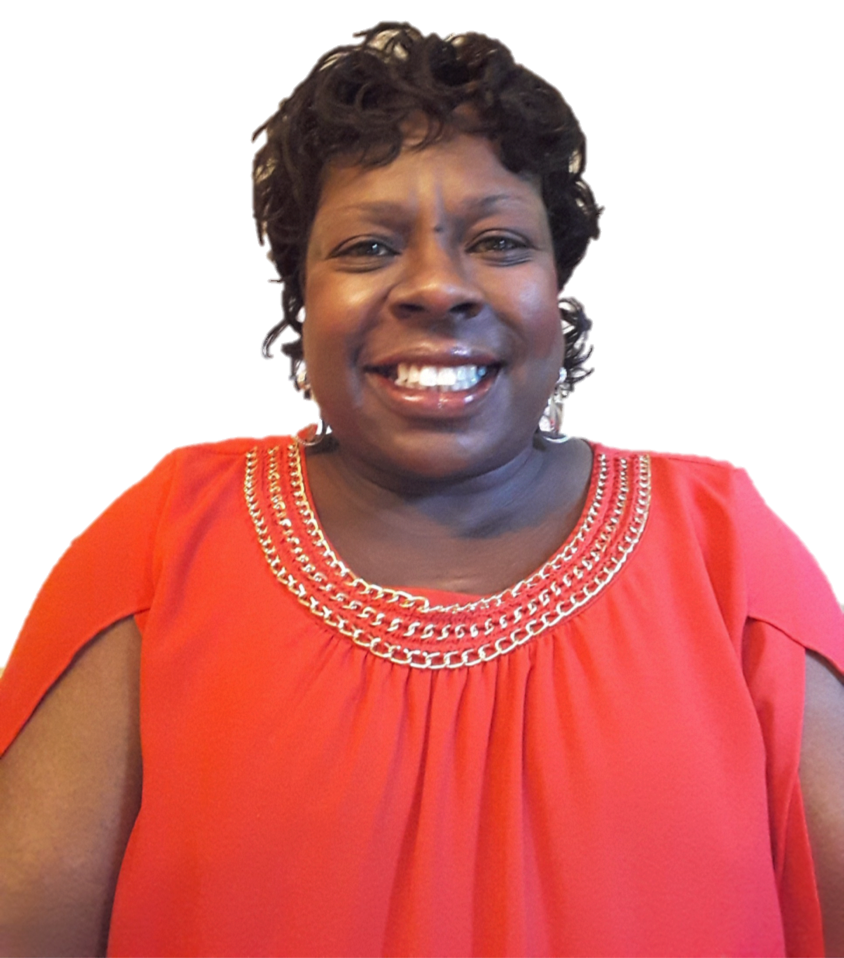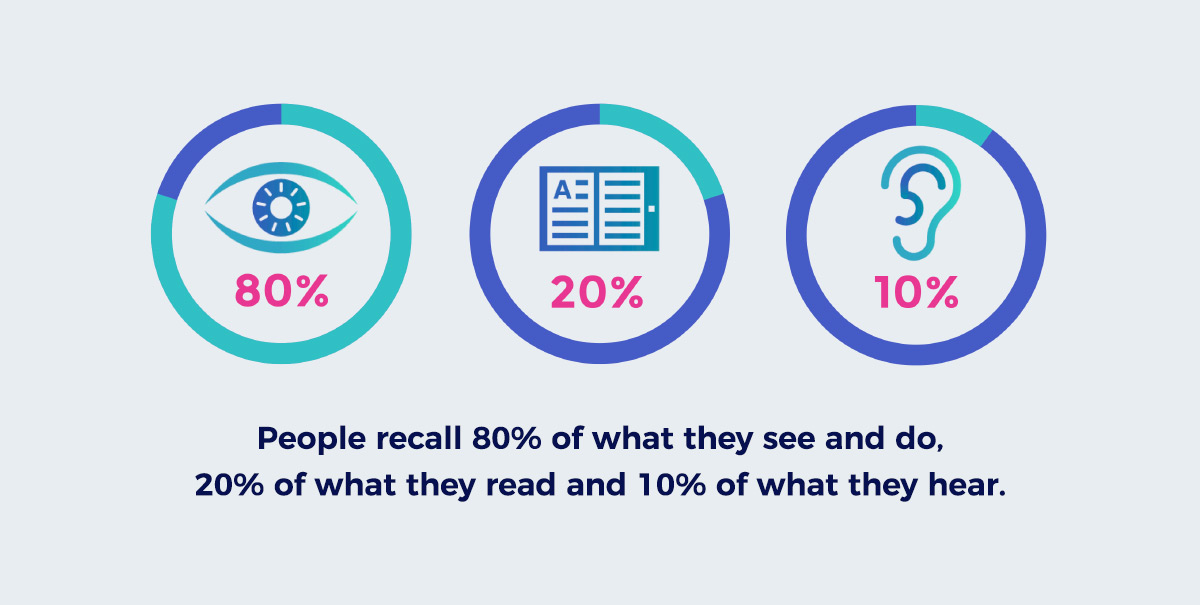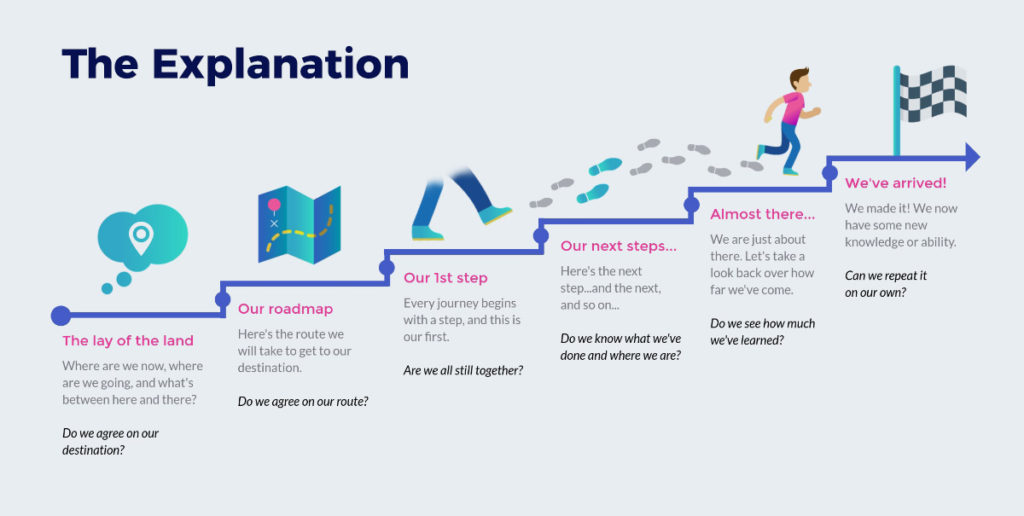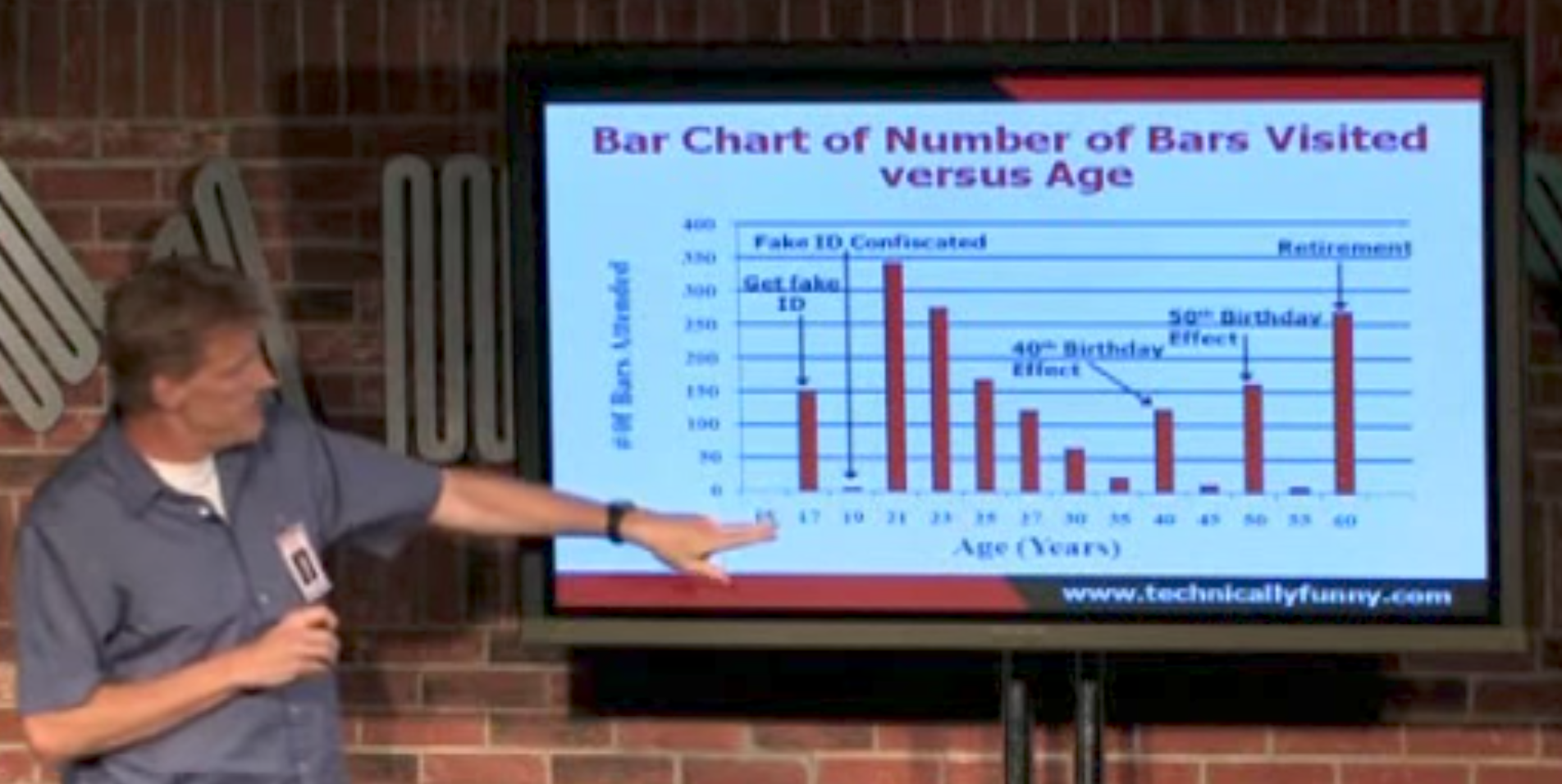

Archive for public speaking seminars – Page 11
By Nayomi Chibana
Guest Blogger
Motivational speaker Lee Jackson said it best when he exclaimed, “Your slides should be a billboard, not a document!”
I couldn’t agree more. Who hasn’t been forced to sit through a presentation in which the speaker simply read off his or her slides, without any forethought as to what would help the audience connect with the message on a deeper level?
And the saddest part is that most presenters today — whether they’re academicians, students or business people — are taught to do the same: Simply transmit information using slides full of bullet points, overused stock photos, and random color schemes.
But the most successful presenters know a secret most don’t: By applying basic design principles, you can significantly increase your audience’s engagement with your message and help them retain information for a longer period of time. After all, a majority of the population (65 percent to be more exact) are visual learners.
Think Visual
For most people, using presentation software to create slide decks has become second nature: You simply choose a design template, insert your text, create bullet points for each slide, add a few images here and there—and voilà! You’re done — right?
Not if you really want to impress your audience.
The most effective speakers have learned to wean themselves off bullet-ridden slides in favor of highly visual presentations that reinforce their words—instead of repeating them.
This is no surprise since human beings are hardwired to process images quicker than textual information. While we can process images in as little as 13 milliseconds, according to one of the latest studies, text takes considerably longer to process.
Sadly, however, most students, academicians, and business people are taught to stick to the old way of creating presentations: full of text-heavy slides that make it harder—not easier—to understand and act upon your message.
The Power of Storytelling
Does this mean that visuals will trump the written word? By no means! Whether you’re dealing with a multimedia presentation, a Hollywood movie or a novel, one thing will always reign supreme: the power of storytelling.
This is why well-designed slides will always start with a good story and good content—not the other way around.
So, the three essential ingredients to a successful presentation are: the content, the design, and the delivery.
We all learned in high school or college that a piece of communication can have one of four purposes: to inform, entertain, inspire or persuade.
These same communicational objectives can be applied to presentation giving. For example, within a business setting, your goal may be to accomplish more than one of these objectives: to inform your audience and also inspire them to take action.
In this case, you may want to use a combination of storytelling techniques and the exposition of facts to get your point across.
In her book Resonate, presentation guru Nancy Duarte proposes a way to weave both of these into your narrative. She suggests thinking about presentations as somewhere between two extremes: a report, full of unexciting numbers and figures, and a story, which has the power to keep viewers at the edge of their seats. While facts are used to inform, stories create memorable experiences.
By shifting between facts that provide a snapshot of the current reality and stories that paint a picture of the ideal situation, you create suspense and desire in your audience to learn what comes next. Duarte visualizes this alternating between facts and stories as a sparkline, which represents the dramatic tension created by comparing what is with what could be.
Brainstorm Ideas
Once you’ve defined the objective of your presentation—whether to inform, entertain, persuade, inspire, or a combination of all of these—you can begin the brainstorming process.
Although you’ve probably made the mistake of opening up PowerPoint and creating your slides without any forethought, the best presentations are the product of careful planning and purposeful brainstorming.
Start by taking a piece of paper and pencil and drawing out your ideas; this will help get your creative juices flowing and allow you to generate ideas freely, without the sense of finality that comes with inserting content onto a slide.
You can use diagrams such as mind maps, Venn diagrams, tree diagrams, and spoke diagrams to illustrate your initial ideas.
Audience Personas
All great communicators know that the key to crafting a message that will resonate with your audience is to first understand their needs, pain points, motivations, and goals. The more diligently you set out to walk a mile in their shoes, the easier it will be to speak their language and offer solutions to their most pressing needs.
Start by asking yourself the following questions:
- Who is your typical audience member? List key demographic and psychographic information, such as age, gender, race, income level, interests, values and personality traits.
- What pressing problem can you help them with? What information do they hope to attain from your talk? What do they hope to achieve with it?
- How do they want to receive information? Are they busy people who want a general overview in an easy-to-process visual presentation? Or are they more interested in a detailed report in document format as well?
- How much do they know about the subject? Use language and terms in accordance with your audience’s knowledge level and familiarity with the subject matter.
- What objections might they have? How might your audience resist your message? Think of ways to address each of these objections.
Create an Audience Journey Map
Next, think of your presentation as a journey in which you will take your audience from point A to point B. What do you want them to do at the end of your presentation? Do you want them to invest in a certain product or cause? Do you want them to change the way they think about a certain problem?
According to Gavin McMahon, co-founder of fassforward Consulting Group, this common story structure transfers new information from the presenter to the audience. Its main goal is to teach new insights or abilities. Visualized as the process of stair climbing, each part of the presentation takes you closer to an enlightened state.
Meanwhile, The Drama is based on the Hero’s Journey, a structure followed by some of our favorite stories, such as The Lord of the Rings and Game of Thrones. The protagonist (could be a brand, representation of a customer, etc.) is engulfed in a problem that can’t be ignored. After descending into crisis and awaiting the worst, there is an unexpected discovery that leads the hero to resurface as a conqueror, with a new lesson and story to tell others.
Then there’s also this commonly used structure recommended by fassforward Consulting Group. It’s a simple formula that starts by engaging your audience with a hook (such as a provocative question or a story) and then proceeds to deliver the meat of your presentation and end with an effective conclusion that circles back to the introduction.
The Big Idea
Once you’ve mapped your audience’s journey, make sure to not lose sight of the main focus of your presentation. Just like an essay or paper needs a thesis statement, your presentation should have one “big idea” that can be summed up in a few sentences. This statement should articulate your unique perspective on an issue and why your audience should care about it.
To build an airtight case within your narrative, you will need to use corroborated facts and figures to back up your claims.
You can start outlining your case by going back to your one big idea and then identifying each of your main points, followed by supporting details. To help you craft an airtight argument, you can use an idea map like this one.
Create a Storyboard
Because a successful presentation is built not just on good content but on an effective design, the next step is to create a visual storyboard, much like those used to outline the content in a video. The overarching theme you decided on in the brainstorming process will be useful for visualizing your deck at this stage, which should contain no more than one idea per slide.
Free Book
To help all communicators — even those without a design background — learn the design principles necessary to create purposeful visual slides, presentation tool Visme put together this free 125-page presentation design guide to creating visual slides with impact.
Based on more than two years of research into what sets the most successful presentations apart from others, this guide is chock-full of visual before-and-after examples, cheat sheets and case studies. If you’re eager to seriously raise the bar on your presentations, but don’t have the time or resources to take presentation design courses, this book is for you.
ABOUT OUR GUEST BLOGGER
 Nayomi Chibana is a journalist and writer for Visme’s Visual Learning Center. She has an M.A. in Journalism and Media from the University of Hamburg in Germany and was an editor of a leading Latin American political investigative magazine for several years. In addition to researching trends in visual communication and next-generation storytelling, she’s passionate about data-driven content.
Nayomi Chibana is a journalist and writer for Visme’s Visual Learning Center. She has an M.A. in Journalism and Media from the University of Hamburg in Germany and was an editor of a leading Latin American political investigative magazine for several years. In addition to researching trends in visual communication and next-generation storytelling, she’s passionate about data-driven content.
We are pleased to once again partner with the Phoenix Business Journal to present our popular “Speak Up and Stand Out” workshop. This session will be held Thursday, Jan. 11, at CCS Training Center in Scottsdale.
The last time we held this workshop in conjunction with the Phoenix Business Journal, it sold out within a few hours. Don’t delay, sign-up today! Use this promo code to get a 20% discount: PHBB. Hope to see you there!
Workshop Description
In today’s fiercely competitive business climate, how well you present yourself can make the difference in getting ahead or going home. When it comes to winning a new client, getting a project approved, or closing the deal, the smallest things can make the biggest difference. You don’t want to blend in you want to stand out!
From shaking hands, exchanging business cards to storytelling these all have a powerful impression on how people perceive you. Most people underestimate the importance of these interactions and just get by. But by knowing a few simple secrets, you can turn that around.
Business Communication expert Paul Barton of Phoenix Public Speaking will teach you the skills to stand out.
In this highly interactive workshop, you will master the basics of:
- Developing an executive presence
- Using your body language to influence and include
- Introducing yourself to make a great first impression
- Exchanging business cards so you are remembered
This is the perfect chance to make a New Year’s resolution and start off 2018 with the confidence to speak up and the skills to stand out!
I’m so proud of my alma mater, Iowa State, for the way they’ve turned their football program around. They’ve defeated two Top 5 teams already, made themselves bowl eligible before Halloween, and are rising fast in the national rankings. According to head coach Matt Campbell, the secret to the Cyclones’ amazing turnaround and stunning success is “doing the unremarkable with remarkable detail.”
Coach Campbell is talking about performing the basics and executing them flawlessly. For example, his team has the fewest penalties in the conference and has not lost a fumble in eight hard-hitting games.
Sometimes in life, when you get the seemingly insignificant things perfect, it can set you up for the big wins. This has been the approach of our Speak Up and Stand Out public speaking workshops and personal coaching program. It’s a highly competitive world out there and so when it comes to winning a new client, getting a project approved, or closing the deal, the smallest things can make the biggest difference.
Common Business Interactions to Get Perfect
Here are some common business interactions that you should execute with remarkable detail:
- Slow down and take the time to perform a handshake correctly.
- Don’t start speaking before you are in speaking position. Likewise, don’t start to sit back down until you have completed your presentation. Even the smallest hint you are ready to sit back down will dimish your conclusion.
- Present a business card rather than simply give one. Tell your story. Likewise, receive a business card rather than take one. Take the time to look at it. Put it away respectfully.
- Introduce yourself with meaningful content and do so succinctly. Stay on point. Stay interesting.
- Tell passionate stories and use examples that follow a logical sequence and conclude with a clear point.
- Choose a seat that allows you to influence and include rather than command and control.
- Listen better. Listen to understand and to know.
Done correctly, these simple business interactions can have a powerful impact on how people perceive you. They can make the difference in getting to the next level or going home. By executing these unremarkable things with remarkable detail, you too can turn your season around and be a winner.
Had a great time presenting a public speaking workshop for the leadership team at Vi Living at Silverstone in Scottsdale this morning. About 30 people attended and we covered everything from where to sit to how to stand to command a room.
Pictured in the photo above are (from left) Kim Bankofier, Community Relations Manager; Paul Barton, Phoenix Public Speaking; Jill Wolverton, Executive Director; and Wes Pudwill, Director of Human Resources.
Contact us to create a customized in-house workshop for you and your team, or to arrange a personal coaching program. You can connect with us using the handy contact form, or you can email us directly at PhoenixPublicSpeaking@Outlook.com or call us at 623-215-4675.
“They may forget what you said, but they will never forget how you made them feel.” – Carl W. Buechner, writer, and theologian
Perhaps more important than the words you say is how you say them. The tone of a speech or business presentation is crucial to engage your audience, to persuade them, and to get them to get out of their chairs to take action.
Words make us think, but it is tone that makes us feel. And ultimately it is how we feel that determines if we’re all in for a cause or committed to follow-through with an assignment.
When we manage people, it’s easy to slip into command-and-control tones. These tones can dampen commitment and damage trust with your audience. Business leaders must be mindful of the following tones and the sometimes unintended messages they can send:
- Parental: I know best. I’m the boss so just do what I say.
- Legal: I’m being really precise because I’m more worried about being avoiding a lawsuit than communicating with you.
- Directive: I want you to perform these tasks. I’m the boss and I don’t have to explain why.
- Traditional Business: I’m phony, impersonal and disconnected from you.
- Informational: I’m more concerned with public appearance than communicating with you.
- Promotional: I’m using pseudo-excitement to try to sell you something you probably don’t want.
In my 20-plus years working with leaders of large corporations, I’ve always found a tone that connotes a trusted partnership works best. Whether you are speaking to customers, shareholders, your own employees, contractors or vendors, you should speak with a tone that says “You are a valued business partner and we’re in this together.”
Striking the right tone can make all the difference. Find a partnership tone that works best for you. And when you do, you’ll move beyond being a mere manager and be on the path to becoming a great leader.
Related Links
Tip #16: Speak Positive: It Works
Finding the Voice of Your Organizations Brand to Communicate with Employees (PowerPoint)
By Beverly Mahone
Guest Blogger
I was flipping through the TV channels recently and came across a Pulitzer Prize-winning journalist and author reading excerpts from her best-selling book on C-Span. The stories she told were extremely interesting and compelling but I couldn’t help but cringe over the sound of her voice. No doubt, she was an expert on the subject she was discussing but in my expert opinion as a professional speaker/coach, she lacked presentation skills. I continued to listen to her while critiquing her communication skills in my mind.
Have you ever been to a conference or meeting where the expert speaking either made you yawn (more than once) or used words you would have to use a dictionary to look up? I’ve seen and heard it time and time again. There are lots of speakers who are very knowledgeable and present interesting information but sometimes their presentation skills are less than average.
Truth be told, many experts in their fields don’t really have what it takes to command an audience. They know their subject very well but, often times, don’t know how to communicate effectively. According to Kathy Caprino of Ella Communications, “Experts simply fail to engage us on an emotional, heartfelt level – they don’t connect in a personal way, or give the sense that they truly care a whit about the audience and its ability to productively use the vast information they know and share. In the end, their lack of a human connection makes their presentations feel overwhelming and unsettling – they push us away with all data, facts and statistics, and no heart and soul.”
And if you can’t hold a live audience, chances are you would really bomb out during a radio, TV or podcast interview.
You might be the queen or king of the social media circles or written a best-selling book but the written word is dramatically different than the spoken word.
Presentation Skills You Can Develop
Here are some speaker tips for conducting a good news media interview or to speak to a live audience:
- Speak with passion about your subject. Don’t overhype – but let the audience know how much you truly enjoy what you do.
- Smile — even if you’re doing a radio interview, the listener can hear it in your voice.
- Let your personality shine through. This falls in line with the passion, but also allows your audience to see various sides of you depending on the topic you’re discussing. No one likes serious all the time—especially if your topic is light-hearted in nature.
- Be aware of your body language. Frowning is a turn-off – unless you are doing it in the context of making a point about something negative. Gesturing naturally is great but looking like you don’t know what to do with your hands will make you look nervous and unprofessional.
- Don’t use $10 words. No one is going to be impressed with all the big words you know. But if you do use them, make sure you can explain them in layman’s terms.
- Gesture even if you’re doing radio or a podcast. People who sit stiff as a board will sound more robotic than human.
- Learn how to pace yourself. Speaking too fast or too slowly will have your audience tuning out. You might want to practice with a friend to see what they think about your pacing.
- Remember, your voice creates an impression. And just like appearances, it could be a lasting one in your favor or cut down on the number of requests for you as a presenter.
- Practice, practice, practice — Join a public speaking group in your area or hire a public speaking coach to help you.
By following these tips, you can be a subject-matter expert and an expert public speaker as well. And that’s a powerful combination.
ABOUT OUR GUEST BLOGGER
 Beverly Mahone is a veteran journalist, author, coach, and professional speaker. After more than 30 years in radio and TV news, Beverly created BAM Enterprises. In addition to working with employers to help them understand how to recruit and train millennials, she also provides professional speaker training. Beverly has appeared on numerous radio and TV talk programs including MSNBC. She has been featured in the New York Times and has written five books including the Amazon Best Sellers How to Get on the News Without Committing Murder and The Baby Boomer/Millennial Divide: Making it Work at WORK. She has written for or been covered by the Huffington Post, Forbes, and Newsweek magazine.
Beverly Mahone is a veteran journalist, author, coach, and professional speaker. After more than 30 years in radio and TV news, Beverly created BAM Enterprises. In addition to working with employers to help them understand how to recruit and train millennials, she also provides professional speaker training. Beverly has appeared on numerous radio and TV talk programs including MSNBC. She has been featured in the New York Times and has written five books including the Amazon Best Sellers How to Get on the News Without Committing Murder and The Baby Boomer/Millennial Divide: Making it Work at WORK. She has written for or been covered by the Huffington Post, Forbes, and Newsweek magazine.
Connect with Beverly: Website | Twitter
You’ve practiced your speech a million times in your office, in the car and even in the shower. You’re ready to deliver it. You step to the stage and someone hands you a microphone. But you haven’t practiced with a microphone. The first thing you do is bump the microphone against your body making a loud noise that irritates your audience. You nearly trip over the microphone wire. Then you hold it up to your mouth and everyone can hear you breathing loudly into it. You begin to speak and your voice is far too loud. Your speech is off to a bad start before you have even begun.
So, how do you avoid microphone mishaps? Follow these tips to master the microphone when public speaking:
- Find out in advance what type of microphone you’ll be using – handheld, lavaliere, lectern-mounted?
- If you know you’re going to speak with a handheld microphone, practice with one in your hand (or at least with some similarly shaped object in your hand) so that you get used to gesturing properly.
- If possible, practice your complete speech with the sound system to uncover any problems well before your presentation.
- Arrive at least 30 minutes early and perform a sound check. Just saying “check one, check two” isn’t good enough. Say a portion of the actual speech so that the sound technician can equalize the range of your voice.
- Determine the appropriate distance from your mouth the microphone needs to be to sound good.
- Beware of distracting vocal noises (popping sharp consonants or heavy breathing) or nonverbal sounds (hitting the lectern or ruffling papers) that might be amplified.
- Get as familiar with the microphone as you can. Where is the on and off switch?
- Be careful not to make private comments. Always assume a microphone is on.
- If you will be speaking with a lavaliere microphone, wear a belt to clip the transmitter on or have a pocket to put it in. You also may want to wear a suit jacket or a blazer to hide the wire.
- Use a high-quality microphone that doesn’t make you sound muffled.
A microphone can be a great tool to help your audience hear the nuances of your voice, which can help you to better connect with them. If you follow the tips outlined in this post, your microphone will enhance your presentation and allow you to deliver a great speech.
Related Posts

I was honored to be spotlighted as an adjunct faculty member at the Art Institute of Phoenix in a recent article. I am currently teaching two public speaking courses to the incredibly talented students there.
The Art Institute teaches photography, film production, graphic and web design, interior design, game art and design, and culinary arts. They are a fascinating bunch of creative minds and I enjoy helping them discover public speaking and business communication skills that I know will help them throughout their personal and professional lives. Read the Article
Whether to use PowerPoint or other presentation software is an important decision when planning out a speech or business presentation (as discussed in Public Speaking Tip #34). If you do decide to create presentation slides make sure they are done correctly and convey the right image for you as a public speaker or business presenter. You can get some great ideas for content and slide design from SlideShare.net (as discussed in Public Speaking Tip #35).
I love the following two videos for the Do’s and Don’ts of using PowerPoint and other presentation software. The first video, done by comedian Don McMillan, is mainly for fun but does make some great points about what not to do. The second video, done by the Presenters Toolkit, gives some great tips to keep in mind when making slides. I hope you enjoy them both.
PowerPoint Don’ts
PowerPoint Do’s
Related Posts
Where to find great PowerPower ideas
When to use PowerPoint and when not to use










